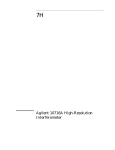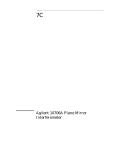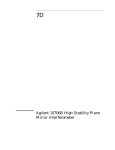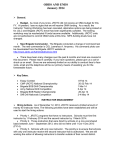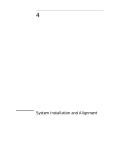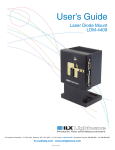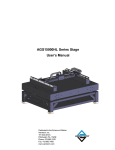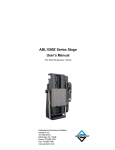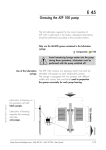Download Agilent 10715A Differential Interferometer
Transcript
7G Agilent 10715A Differential Interferometer Chapter 7G Agilent 10715A Differential Interferometer Description Description The Agilent 10715A Differential Interferometer (see Figure 7G-1) allows differential measurements to be made between two plane mirrors — the reference plane mirror and the measurement plane mirror. The reference mirror is supplied with the Agilent 10715A. The measurement mirror must be a plane mirror such as the Agilent 10724A Plane Mirror Reflector or other user-supplied plane mirror. The major benefit of the Agilent 10715A interferometer is that the optical path is common to both the reference and the measurement beams (see Figure 7G-2). This makes the Agilent 10715A extremely tolerant of changes such as thermal expansion or changes in air characteristics. When used in a positioning system, the small reference mirror supplied can be mounted very close to the measurement mirror. The advantages of the common beam path and the small reference mirror combine to significantly reduce deadpath. Deadpath is the optical path length difference between the reference and measurement beams when the stage is at its initial “zero” position. Reducing deadpath results in extremely high stability and resistance to spurious changes in the optical path. Since the measurement beam travels twice between the interferometer and the plane mirror, the resolution of the measurement is twice that of a linear or single-beam interferometer. A turned configuration (Agilent 10715A-001) is available to turn the beam 90 degrees, thereby eliminating the need for a beam bender. The orientation of the optics determines which frequency polarization is in the measurement or reference path, thus affecting direction sense. A differential measurement is one in which both the reference beam and the measurement beam travel to external mirrors outside the interferometer housing. This allows measurement of the relative positions of the two external mirrors, either or both of which may be moving. Viewed another way, this allows measuring the motion of one reflector relative to a reference datum elsewhere in the machine, external to the interferometer itself. This is unlike the typical interferometer configuration because usually the reference beam path length does not change; in differential configurations, it can. For more information about differential measurements, see the Chapter 3, “System Design Considerations,” in this manual. 7G-2 User’s Manual Chapter 7G Agilent 10715A Differential Interferometer Description TIAL I N T E R 10 METER RO FE DI FFER EN 71 5A Agilent 10715A Differential Interferometer Figure 7G-1. Agilent 10715A Differential Interferometer User’s Manual 7G-3 Chapter 7G Agilent 10715A Differential Interferometer Description MEASUREMENT PATH (ffA) f ±2 ∆f ∆ λ/4 Plate fA± ∆f Aperture B fA fA±2 ∆f Aperture A fA±2 ∆f fA±2 ∆f fA ± ∆ f Reference Mirror λ/4 Plate f ± ∆f Stage Mirror Agilent 10715A (Top View) REFERENCE PATH (fB) λ/4 Plate Aperture B Aperture A λ/4 Plate Mirror Stage Mirror Agilent 10715A (Top View) COMPOSITE (ffA and fB) fA±2 ∆f λ/4 Plate f fA fA±2 ∆f ∆ Aperture B Aperture A±2 ∆ f fA ± ∆ f fA±2 ∆f ∆ λ/4 Plate Mirror A± ∆f Stage Mirror Agilent 10715A (Top View) LEGEND = fA = = fB = fA and fB Rounded corners are used to help you trace paths. Figure 7G-2. Agilent 10715A Differential Interferometer — laser beam path 7G-4 User’s Manual Chapter 7G Agilent 10715A Differential Interferometer Special Considerations (Configuration Effects) Special Considerations (Configuration Effects) For purposes of convention, aperture B will be considered the input aperture when referring to all configurations. Note that the choice of input aperture is one of the configuration variables that affects the direction sense. The Agilent 10715A Differential Interferometer is available in two configurations; the Agilent 10715A (see Figure 7G-3) and the Agilent 10715A-001 (see Figure 7G-4). Both have the same direction sense; however, it may change, depending on the mounting and orientation as shown in Table 7G-1. Configurations with the same direction sense Standard configuration Agilent 10715A The Agilent 10715A is assembled and shipped in the “Standard” configuration (see Figure 7G-3). Turned configuration Agilent 10715A-001 The primary reason for using the Agilent 10715A-001 is to turn the beam. In the “Standard” configuration, the beam is not turned (it passes straight through the interferometer to the measurement reflector). Agilent 10715A upside down Mounting the Agilent 10715A in this manner has no effect on the direction sense, assuming the same input aperture is used. Table 7G-1 shows the direction sense for various optical configurations. Configurations that change the direction sense Agilent 10715A Input and Output Apertures The laser beam may enter either of the two apertures on the Agilent 10715A or Agilent 10715A-001. These apertures are labeled A and B. If aperture A is used as the input, then aperture B is the output aperture and vice-versa. Functionally, it is arbitrary which aperture is the input aperture. However, the choice of A or B does determine which frequency is passed to the measurement mirror and thereby determines the direction sense. User’s Manual 7G-5 Chapter 7G Agilent 10715A Differential Interferometer Special Considerations (Configuration Effects) AGILENT 10715A STANDARD CONFIGURATION Adapter Plane Mirror Converter A TI L I NTERF DI FFERE N B ETER OM ER A 10715A Figure 7G-3. Agilent 10715A Standard Configuration AGILENT 10715A-001 TURNED CONFIGURATION Adapter A TI L I NTERF DI FFERE B ETER OM ER A N Plane Mirror Converter 10715A Figure 7G-4. Agilent 10715A-001 Turned Configuration 7G-6 User’s Manual Chapter 7G Agilent 10715A Differential Interferometer Mounting Agilent 10715A orientation (horizontal or vertical) The Agilent 10715A may be mounted on a horizontal surface or a vertical surface. The direction sense will be different for each orientation. If any two of the conditions described above, including the laser head orientation, are changed there is no net change in the direction sense. Table 7G-1. Agilent 10715A direction sense Laser Head Laser Head Orientation Horizontal or Rolled 90° About Beam Agilent 10715A Input Aperture A or B Agilent 10715A Orientation Horizontal or Vertical F1 Path Horizontal Ref Vertical Meas B Horizontal Meas A Horizontal Meas Vertical Ref Horizontal Ref Vertical Meas A Horizontal Agilent 5517A/B/C/D F1 Horizontal F2 Vertical Rotated 90° B Mounting Adjustable mounts The Agilent 10711A Adjustable Mount provides a convenient means of mounting, aligning, and securely locking the Agilent 10715A interferometer in position. Since the mount allows some tilt and yaw adjustment, the need for custom fixturing is minimized. The mount allows the interferometer to be rotated about its centerline, simplifying installation. Fasteners The Agilent 10715A interferometer is supplied with English mounting hardware, which is required to fasten it to its adjustable mount. User’s Manual 7G-7 Chapter 7G Agilent 10715A Differential Interferometer Installation and Alignment Installation and Alignment The Agilent 10715A Differential Interferometer alignment procedure has more steps than those for other Agilent interferometers because its reference mirror must also be aligned. Before discussing the alignment procedure for this interferometer, details on beam locations and reference mirror mounting will be covered. Configurations Two configurations are available for the Agilent 10715A Differential Interferometer, allowing flexibility in optical layout of a measurement system. They are: • Standard • Turned (10715-001) Figure 7G-5 shows the location of the measurement and reference beams for the standard configuration using input aperture B. The beams are switched if input aperture A is used. STANDARD AGILENT 10715A BEAM LOCATIONS Adapter L I NTERF DI FFERE A TI Reference Beam ETER OM ER N Measurement Beam 10715A Reference Beam Measurement Beam 12.7 mm (0.5) Figure 7G-5. Beam locations for standard Agilent 10715A Differential Interferometer 7G-8 User’s Manual Chapter 7G Agilent 10715A Differential Interferometer Installation and Alignment Figure 7G-6 shows the location of the measurement and reference beams for the turned configuration (Agilent 10715A-001) using input aperture B. The beams are switched if input aperture A is used. AGILENT 10715A-001 TURNED CONFIGURATION BEAM LOCATIONS 8.1 mm (0.32) Measurement Beam Reference Beam 12.7 mm (0.5) Measurement Beam L I NTERF DI FFERE A TI ETER OM ER N Reference Beam 10715A Figure 7G-6. Beam locations for Agilent 10715A-001 Turned Configuration Reference mirror mounting The Agilent 10715A interferometer is supplied with a small reference plane mirror (see Figure 7G-7). Mount the mirror on an adjustable mount so proper alignment can be obtained. When alignment is achieved, rigidly fix the position of the mirror. The recommended method is to use an adhesive to attach the mirror to the mount. The adhesive should not induce stress into the glass during curing. Place the mirror-and-mount assembly as close as possible to the near end of travel of the stage to reduce potential deadpath errors. User’s Manual 7G-9 Chapter 7G Agilent 10715A Differential Interferometer Installation and Alignment REFERENCE MIRROR FOR AGILENT 10715A (2X) 3.6 mm R (0.14) 8.1 mm (0.32) (2X) 3.2 mm R (0.13) 6.3 mm (0.25) 22.9 mm (0.90) Either Both Reference or Measurement Beams 12.7 mm (0.50) 5.1 mm (0.20) 57 o 23' Either Both Reference or Measurement Beams 3.4 mm (0.13) 5.1 mm (0.20) 9.9 mm (0.39) 18.3 mm (0.72) Agilent Part Number: 10715-20205 Weight: 3.2 grams (0.11 ounce) Figure 7G-7. Agilent 10715A Interferometer (reference mirror) Alignment aid Alignment Aid (Agilent Part Number 10706-60001) is included with the Agilent 10715A interferometer. This is the same alignment aid used on the Agilent 10706A Plane Mirror Interferometer. For information about use of this alignment aid, see subchapter 7C in this manual, which deals with the Agilent 10706A Plane Mirror Interferometer. Alignment procedure This alignment procedure is similar to that for the Agilent 10706A Plane Mirror Interferometer. The main difference is that in this procedure the laser beam must pass through small apertures, which requires fairly precise alignment to avoid clipping part of the beam. It is assumed that the measurement mirror has been aligned perpendicular to the axis of travel. 7G-10 User’s Manual Chapter 7G Agilent 10715A Differential Interferometer Installation and Alignment The alignment procedure below is for the “Standard Configuration”, with the laser beam entering the interferometer in aperture B. The alignment procedure for the “Turned Configuration” is similar, except it is more sensitive to angular alignment of the interferometer. 1 Select the small aperture on the laser head. 2 Roughly align the laser beam for each axis perpendicular to the measurement mirror. This is done by autoreflecting off this mirror and adjusting the laser head or beam bender until the reflected beam is centered in the small aperture on the laser head. 3 Move the interferometer side-to-side so that the laser beam enters the input aperture (aperture B in this example). 4 Place a rectangular gage block over the input aperture so that it reflects the laser beam back toward the laser. (See Figure 7G-8.) L I NTERF DI FFERE A TI ETER OM ER Laser Beam N AGILENT 10715A WITH GAGE BLOCK 10715A Gage Block Figure 7G-8. Agilent 10715A with gage block in position 5 Adjust the differential interferometer in pitch and yaw until the laser beam is autoreflected back into the laser head. This insures proper alignment. It may be necessary to move the interferometer again to center the laser beam on the input aperture (aperture B). Use a piece of translucent tape to help observe the beam. 6 Once the autoreflection alignment of the interferometer is complete, remove the gage block and select the large aperture on the laser head. Two parallel unclipped beams should now leave the interferometer. (See Figure 7G-9.) User’s Manual 7G-11 Chapter 7G Agilent 10715A Differential Interferometer Installation and Alignment Note that the autoreflection procedure above is used only to reduce clipping, and is not as critical as the autoreflection procedure used to reduce cosine error. As long as the two beams are not clipped, the alignment of the interferometer is adequate. One of the two beams will be directed to the measurement mirror; the other will be directed to the stationary reference mirror. Which beam goes to which mirror affects only the direction sense (discussed in the “Effect of Optics on Measurement Direction Sense” section of Chapter 3, “System Design Considerations,” of this manual). Since it is important that the beam going to the measurement mirror be properly aligned to avoid cosine error, this alignment will be performed first. Alignment is iterative because both the incoming beam and the interferometer require adjustment. AGILENT 10715A VIEWED FROM PLANE MIRROR Reference Beam Measurement Beam Figure 7G-9. Differential interferometer as viewed from plane mirrors 7 Place the alignment aid over the output aperture (plane mirror converter) of the Differential Interferometer such that the beam going to the measurement mirror (which becomes the measurement beam) passes through the alignment target. (See Figure 7G-10.) 7G-12 User’s Manual Chapter 7G Agilent 10715A Differential Interferometer Installation and Alignment AGILENT 10715A WITH ALIGNMENT AID RE AF MOV TE R ET AL ARG Ag IG ile NIN ET nt Te G ch no log ies Alignment Aid Part Number 10706-60001 Measurement Beam Figure 7G-10. Agilent 10715A with alignment aid attached over measurement beam 8 This beam should clear the reference mirror and strike the measurement mirror. Select the small aperture on the front turret of the laser head. Adjust the laser beam until the beam is autoreflected back through the small aperture of the laser head. This ensures that the beam is perpendicular to the measurement mirror. This step requires pitching and yawing the laser head, beam benders, or beam splitters depending on optical layout. Steps 4 and 5 should be performed after each adjustment to prevent the interferometer from clipping the laser beam. 9 Remove the alignment aid. Laser (measurement) beams should now exit the interferometer aperture in diametrically opposite positions. (See Figure 7G-11.) AGILENT 10715A VIEWED FROM PLANE MIRRORS WITH MEASUREMENT BEAMS ALIGNED Measurement Beams Figure 7G-11. Differential interferometer as viewed from plane mirrors with measurement beams aligned User’s Manual 7G-13 Chapter 7G Agilent 10715A Differential Interferometer Installation and Alignment 10 Switch to the large aperture on the laser head. 11 Check to ensure that both measurement beams pass clear of the stationary reference mirror. If necessary, move the reference mirror until both measurement beams pass clear. The return beam should now pass unclipped to the receiver. 12 Replace the alignment aid over the output aperture of the differential interferometer such that the beam going to the reference mirror (which becomes the reference beam) passes through the alignment aid. (See Figure 7G-12.) The full reference beam should strike the reference mirror. Select the small aperture on the laser head. If the reference mirror is parallel to the movable mirror, the reference beam will now be reflected back to the small aperture on the laser head. If not, the reference mirror must be adjusted in pitch and yaw until the reference beam is centered on the small aperture. 13 Remove the alignment aid. The measurement beam and the reference beam should now exit the interferometer aperture in diametrically opposite positions. Switch the laser head to its large aperture. (See Figure 7G-13.) The measurement beam and the reference beam should pass unclipped to the receiver. Verify this by checking that these beams are centered in the output aperture (aperture A). Use a piece of translucent tape to help observe the laser beam. AGILENT 10715A WITH ALIGNMENT AID Alignment Aid Part Number 10706-60001 ET RG TA ING IGN ies log hno Tec t n gile VE L MO RE ER A T AF A Reference Beam Figure 7G-12. Alignment aid attached over reference beam 7G-14 User’s Manual Chapter 7G Agilent 10715A Differential Interferometer Specifications and Characteristics AGILENT 10715A VIEWED FROM PLANE MIRRORS WITH PROPER ALIGNMENT Reference Beam Measurement Beam Measurement Beam Reference Beam Figure 7G-13. Differential interferometer as viewed from plane mirrors with proper alignment Specifications and Characteristics Specifications describe the device’s warranted performance. Supplemental characteristics (indicated by TYPICAL or NOMINAL) are intended to provide non-warranted performance information useful in applying the device. Using electronic resolution extension, the system resolution is increased significantly. Depending on the system, an additional resolution extension factor of 32 (for Agilent 10885A and 10895A) or 256 (for Agilent 10897B and 10898A) is usually available. Interferometer Fundamental Optical Resolution System Resolution 1 (see NOTE) System Resolution 2 (see NOTE) Agilent 10715A λ /4 (158.2 nm, 6.2 µin) λ /128 (5.0 nm, 0.2 µin) λ /1024 (0.62 nm, 0.024 µin) NOTE The system resolution 1 is based on using 32X electronic resolution extension. This is available with the Agilent 10885A and Agilent 10895A electronics. The system resolution 2 is based on using 256X electronic resolution extension. This is available with the Agilent 10897B and Agilent 10898A electronics. User’s Manual 7G-15 Chapter 7G Agilent 10715A Differential Interferometer Specifications and Characteristics Agilent 10715A Differential Interferometer (and 10715A-001 Turned Configuration) Specifications Weight: 504 grams (1.1 pounds) Dimensions: see figure below Materials Used: Housing: Stainless Steel and Aluminum NOTE: Flatness deviations will appear as measurement errors when the mirror is translated across the beam. Mount should be kinematic so as not to bend mirror. If accuracy requirements demand it, mirror flatness might be calibrated (scanned and Optics: Optical Grade Class stored in the system controller) to be used as a correction Adhesives: Vacuum Grade factor. Optical Efficiency: (including a 98% efficient plane mirror reflector and MEASUREMENT OR REFERENCE MIRROR ALIGNMENT the Reference Mirror) REQUIREMENTS VS DISTANCE: Typical: 36% Maximum Angular Misalignment (pitch and yaw): Depends on distance between interferometer and plane mirror. Worst Case: 25% Fundamental Optical Resolution: λ /4 Non-linearity Error: <2.2 nm (0.09 µin) MEASUREMENT PLANE MIRROR RECOMMENDATIONS Reflectance: 98% for 633 nanometers at normal incidence Typical values are: ± 2.5 arc-minutes for 152 mm (6 inches) ± 1.3 arc-minutes for 305 mm (12 inches) ± 0.7 arc-minute for 508 mm (20 inches) Optical Surface Quality: 60–40 per Mil-0-13830 Thermal Drift: <0.002 micron/°C (0.08 µ/°C) typical Flatness: Depending on the application and accuracy requirements of Fundamental Optical Resolution: λ /4 the application, mirror flatness may range from λ /4 to λ /20; i.e., 0.16 to Non-linearity Error: <3.5 nm (0.14 µinch) 0.03 µmeters (6 to 1.2 µinches). 90.2 mm (3.55) (See Note) 12.7 mm (0.50) SYM @ Center Line 12.7 mm (0.50) 38.9 mm (1.53) DIFFERE N B INTERF AL E TI E MET R RO A 85.9 mm (3.38) 32.0 mm (1.26) 10715A 8.1 mm (0.32) 23.9 mm (0.94) 6-32 UNC (4 Places) Thru Clearance For No. 4 or 25 mm 28.4 mm (1.12) 32.0 mm (1.26) To Mirrors From Laser 12.7 mm (0.50) 38.1 mm (1.50) 28.4 mm (1.12) Note To Receiver 14.0 mm m (0.55) For 10715A-001, this dimension is 100.1mm (3.94). Agilent 10715A Differential Interferometer (and Agilent 10715A-001 Turned Configuration) — dimensions 7G-16 User’s Manual Product specifications and descriptions in this document subject to change without notice. Copyright (C) 2002 Agilent Technologies Printed in U.S.A. 07/02 This is a chapter from the manual titled: Laser and Optics User's Manual For complete manual, order: Paper version: p/n 05517-90045 CD version: p/n 05517-90063 This chapter is p/n 05517-90114
















